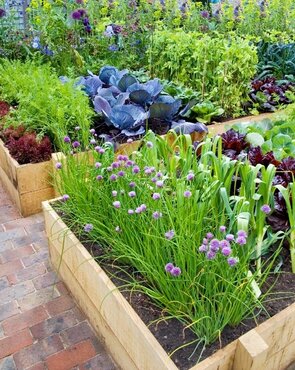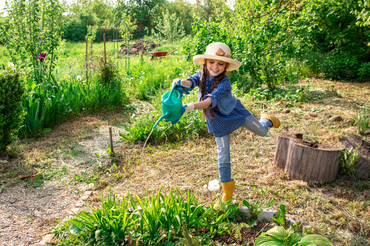
Starting your own kitchen garden this spring
A lush and thriving kitchen garden is something to be proud of. It doesn’t matter how you do it – whether you're vegetable gardening in pots, raised beds or from seed. Nothing beats using the freshest ingredients for the kitchen table, straight from your own backyard, windowsill or balcony and it is ridiculously popular right now.
There are plenty of ways to grow your own vegetables. You could plant them in containers, grow them in a vegetable garden, or on a smaller scale in patio containers. With these 5 tips below on how to plan a kitchen garden to grow healthy, homegrown crops, and get inspiration for your own kitchen garden.
1.Starting your own kitchen garden
Early spring is the perfect time to start your vegetable gardening. Decide on the size of the plot you would like. Make sure you keep to a size you can manage. A large vegetable garden with room to grow everything will take a lot of work. You can also consider a smaller plot with smaller varieties, produce mixed in among flower beds, or planting in containers, ideal if you only have a balcony or patio.
2. Choose the best spot for your kitchen garden
The amount of space and light of your chosen growing spot will be the most important factor in what you can grow. You need to understand how much room each plant needs to produce to their full ability, in a raised bed or pot, before you get started.
To understand how much space each vegetable, herb, fruit trees or soft fruit bushes needs, check the seed packet and then select your pots and containers accordingly because this will make your life a lot easier. To achieve the best results when growing fruit, herbs and vegetables you need:
-
A sunny spot: Preferably one that gets the morning sun, and around six to eight hours of direct sunlight daily. Vegetables need as much light as possible to grow quickly and well. Track the sun throughout the day to see where shadows fall. If you don’t have that much sun in your garden, there are some crops that tolerate shade, such as blackberries, raspberries cherries, blackcurrants and rhubarb.
-
Protection from wind: A permeable barrier, such as a hedge or windbreak protects your crops and plants from wind.
-
Fertile soil: Provide the plants and crops in your kitchen garden with the best conditions and give them soil enriched with compost.
3. Decide on what vegetables and fruits you want to grow
Grow what you love to eat, and as much as you need. Make a list of your favorites, include different varieties of vegetables, fruits and herbs you enjoy, then look at your space and growing conditions and narrow your selection.
If you’re a beginner, try and keep things simple! The concept of growing your own produce is exciting, try to temper the urge to start all the seeds & bulbs and to plant all the veg you can get your hands on. Work with what you have, start small and with experience you’ll be able to know what you can take on for success!
Did you know that a kitchen garden is a great opportunity for growing organic?
If you do have a small space and are more inclined to start container gardening, try salad leaves such as baby leaf spinach in shallow trays. Choose trailing tomatoes for in baskets or windowsill boxes. Perpetual strawberries also grow well in deep boxes, but regular watering is essential! Zucchini/courgettes and dwarf runner beans crop well in large tubs. In very hot sunny spots, aubergine and sweet peppers are good, as are herbs such as basil and sage. Seed potatoes are a doddle to grow with peat-free compost in an old compost bag or plastic dustbin for example.
4. Get the best value from your kitchen garden
With this small list below you can get the most out of your kitchen garden, keep in mind:
-
Grow high-value crops that take up little space. Tomatoes are high maintenance and need lots of watering and feeding, but they grow vertically and produce lots of fruit.
-
Choose crops that are seemingly expensive to buy compared with growing them yourself. Like herb garden picks, such as sage, mint, thyme, parsley and rosemary. These are easy to grow and you’ll be able to harvest them fresh for up to nine months of the year. Many herbs are perennial and will keep coming back year after year.
-
Grow crops that taste better when fully ripened and fresh from the land, such as strawberries.
5. What to do in your kitchen garden in march
What can you do in your kitchen garden when spring has arrived and better weather is on the way?
-
March is the main month for sowing many crops, including leeks, parsnips, peas and spinach
-
Plant asparagus!
-
Plant out the first onion sets, potatoes, garlic, shallots and artichokes
-
Fertilize your fruit and vegetables
Find everything you need for you kitchen garden at Horticentre
At Horticentre we have a passion for gardening! Our professionals are available to help you with planning and organizing your very own Kitchen garden. In our selection you find garden tools, seeds, bulbs and everything you need to start or keep going on your kitchen garden this spring. Pay us a visit at Horticentre in Overton or have a look in our webshop!




